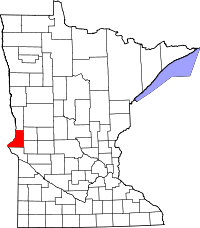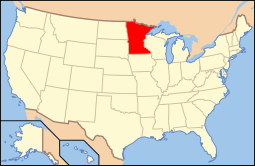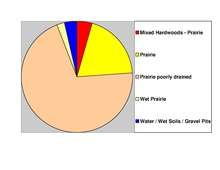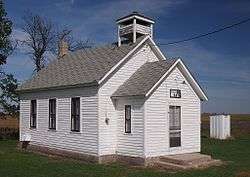Traverse County, Minnesota
| Traverse County, Minnesota | |
|---|---|
|
Old District No. 44 School | |
 Location in the U.S. state of Minnesota | |
 Minnesota's location in the U.S. | |
| Founded |
February 20, 1862 (created) 1881 (organized)[1] |
| Named for | Lake Traverse[2] |
| Seat | Wheaton |
| Largest city | Wheaton |
| Area | |
| • Total | 586 sq mi (1,518 km2) |
| • Land | 574 sq mi (1,487 km2) |
| • Water | 12 sq mi (31 km2), 2.0% |
| Population (est.) | |
| • (2015) | 3,401 |
| • Density | 6.2/sq mi (2/km²) |
| Congressional district | 7th |
| Time zone | Central: UTC-6/-5 |
| Website |
www |
Traverse County (local pronunciation: /ˈtrævərs/ TRAV-ərs) is a county located in the U.S. state of Minnesota. As of the 2010 census, the population was 3,558,[3] making it the least-populous county in Minnesota. Its county seat is Wheaton.[4] The county was founded in 1862 and organized in 1881.
Geography
According to the U.S. Census Bureau, the county has a total area of 586 square miles (1,520 km2), of which 574 square miles (1,490 km2) is land and 12 square miles (31 km2) (2.0%) is water.[5]

Lakes
- Lake Traverse - east three-quarters in Windsor Township, west quarter in Folsom Township, east edge in Lake Valley Township, east edge in Walls Township
- Mud Lake - Lake Valley Township
- Saint Marys Lake - Tara Township
- Wet Lake - Arthur Township
Major highways
 U.S. Route 75
U.S. Route 75 Minnesota State Highway 9
Minnesota State Highway 9 Minnesota State Highway 27
Minnesota State Highway 27 Minnesota State Highway 28
Minnesota State Highway 28 Minnesota State Highway 117
Minnesota State Highway 117
Adjacent counties
- Wilkin County (north)
- Grant County (northeast)
- Stevens County (southeast)
- Big Stone County (south)
- Roberts County, South Dakota (southwest)
- Richland County, North Dakota (northwest)
Demographics
| Historical population | |||
|---|---|---|---|
| Census | Pop. | %± | |
| 1870 | 13 | — | |
| 1880 | 1,507 | 11,492.3% | |
| 1890 | 4,516 | 199.7% | |
| 1900 | 7,573 | 67.7% | |
| 1910 | 8,049 | 6.3% | |
| 1920 | 7,943 | −1.3% | |
| 1930 | 7,938 | −0.1% | |
| 1940 | 8,283 | 4.3% | |
| 1950 | 8,053 | −2.8% | |
| 1960 | 7,503 | −6.8% | |
| 1970 | 6,254 | −16.6% | |
| 1980 | 5,542 | −11.4% | |
| 1990 | 4,463 | −19.5% | |
| 2000 | 4,134 | −7.4% | |
| 2010 | 3,558 | −13.9% | |
| Est. 2015 | 3,401 | [7] | −4.4% |
| U.S. Decennial Census[8] 1790-1960[9] 1900-1990[10] 1990-2000[11] 2010-2015[3] | |||

As of the census of 2000, there were 4,134 people, 1,717 households, and 1,129 families residing in the county. The population density was 7 people per square mile (3/km²). There were 2,199 housing units at an average density of 4 per square mile (1/km²). The racial makeup of the county was 96.42% White, 0.02% Black or African American, 2.81% Native American, 0.27% Asian, 0.07% Pacific Islander, 0.05% from other races, and 0.36% from two or more races. 1.21% of the population were Hispanic or Latino of any race. 52.2% were of German, 13.0% Norwegian, 7.6% Swedish and 5.4% Irish ancestry.
There were 1,717 households out of which 28.30% had children under the age of 18 living with them, 57.00% were married couples living together, 6.00% had a female householder with no husband present, and 34.20% were non-families. 32.00% of all households were made up of individuals and 19.20% had someone living alone who was 65 years of age or older. The average household size was 2.34 and the average family size was 2.97.
In the county the population was spread out with 25.30% under the age of 18, 5.60% from 18 to 24, 21.70% from 25 to 44, 21.20% from 45 to 64, and 26.20% who were 65 years of age or older. The median age was 43 years. For every 100 females there were 96.70 males. For every 100 females age 18 and over, there were 93.80 males.
The median income for a household in the county was $30,617, and the median income for a family was $39,655. Males had a median income of $29,821 versus $20,100 for females. The per capita income for the county was $16,378. About 9.30% of families and 12.00% of the population were below the poverty line, including 13.10% of those under age 18 and 10.80% of those age 65 or over.
Communities
Cities
- Browns Valley
- Dumont
- Tintah
- Wheaton (county seat)
Townships
Unincorporated communities
See also
References
- ↑ "Minnesota Place Names". Minnesota Historical Society. Retrieved March 19, 2014.
- ↑ Upham, Warren (1920). Minnesota Geographic Names: Their Origin and Historic Significance. Minnesota Historical Society. p. 550.
- 1 2 "State & County QuickFacts". United States Census Bureau. Retrieved September 1, 2013.
- ↑ "Find a County". National Association of Counties. Retrieved 2011-06-07.
- ↑ "2010 Census Gazetteer Files". United States Census Bureau. August 22, 2012. Retrieved October 25, 2014.
- ↑ Nelson, Steven (2011). Savanna Soils of Minnesota. Minnesota: Self. pp. 65 - 67. ISBN 978-0-615-50320-2.
- ↑ "County Totals Dataset: Population, Population Change and Estimated Components of Population Change: April 1, 2010 to July 1, 2015". Retrieved July 2, 2016.
- ↑ "U.S. Decennial Census". United States Census Bureau. Retrieved October 25, 2014.
- ↑ "Historical Census Browser". University of Virginia Library. Retrieved October 25, 2014.
- ↑ "Population of Counties by Decennial Census: 1900 to 1990". United States Census Bureau. Retrieved October 25, 2014.
- ↑ "Census 2000 PHC-T-4. Ranking Tables for Counties: 1990 and 2000" (PDF). United States Census Bureau. Retrieved October 25, 2014.
 |
Richland County, North Dakota | Wilkin County | Grant County |  |
| |
||||
| ||||
| | ||||
| Roberts County, South Dakota | Big Stone County | Stevens County |
Coordinates: 45°46′N 96°28′W / 45.77°N 96.47°W
